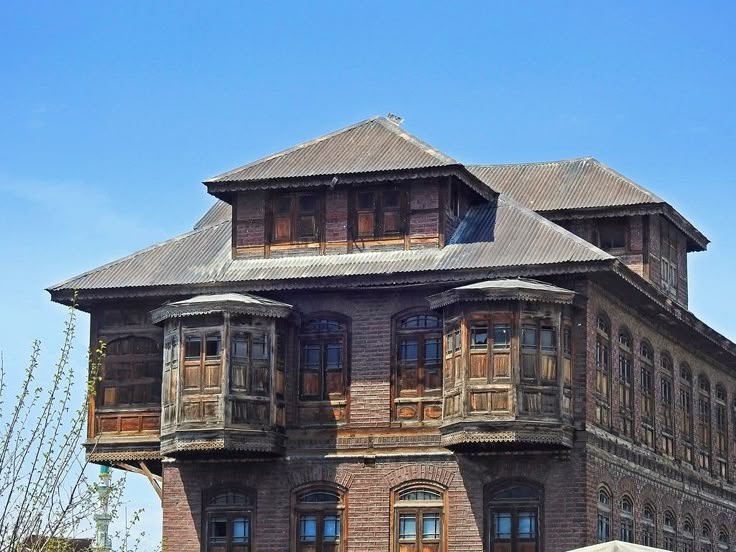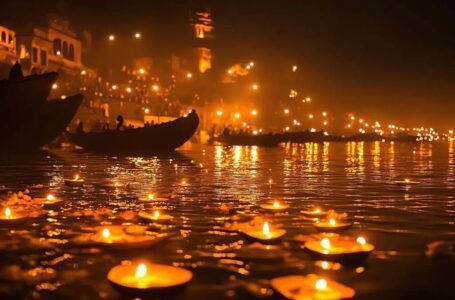Where Tradition Meets Beauty and Craftsmanship: Kashmiri Architecture

– Bhoomee Vats
On his trip to Kashmir, Emperor Jahangir states, “If there is a paradise on earth, it is this, it this, it is this.” This statement is not limited to the beauty and scenic views of Kashmir’s hills only; it extends to the houses and buildings erected there, which combine tradition with the beauty of nature. Even after being a disputed land, Jammu and Kashmir houses the most incredible examples of craftsmanship and architecture, which are not only beautiful but also align with the weather conditions of the hilly areas. Kashmir’s economy is primarily dominated by agriculture, tourism, and handicrafts, which makes it impossible to rebuild the whole state from scratch, especially cities like Srinagar. Because of this, the state looks predominantly the same as it looked 300 years ago, other than the roads and some major infrastructural changes.
The settlement pattern mainly relies on the Jhelum River, which flows through the valley of Kashmir and into the Chenab River, specifically in the state’s summer capital, Srinagar. The river has historically served as a vital transportation route, which encouraged the emergence of ghats and waterfront settlements. The course of the river and its surrounding floodplains have determined the layout of the settlements, developing many areas in a linear way along the banks of the river.
History’s Imprint
Jammu and Kashmir is not just merely a place of snow and hills; every nook and cranny tells a different story- a history, which is not just a part of general knowledge for all, but contains the soul and spirit of the state. This history is visible in every form of architecture present there, be it the small houses or the Ziarats, temples, and mosques that exist there. The ancient temples of the state reflect the influence of the Indo-Aryan style, marked by the use of wood with intricate and detailed carvings. Buddhism left a unique mark on the place, and a prime example of that is the Parihaspora ruins, featuring a structure with ornate carvings on stone with the use of symmetry and simplicity.
The blend of Persian and Central Asian styles with the existing features of Kashmiri elements is the gift of the Islamic influence on the state’s architecture. This integration of different elements can be seen in the mosques and shrines, which often contain an open courtyard, domes, multi-tiered roofs, and widespread gardens. The local Kashmiri styles combine with Islamic styles in the form of syncretism, which can be seen in the use of floral designs and calligraphy, either on wooden structures or on walls. One new dimension introduced to the architectural marvel of Kashmir was the element of garden and water. Shalimar Bagh and Nishat Bagh, two Mughal gardens, are known for their symmetrical layouts, terraced lawns, and the elements of water, which enhance their beauty.
Traditional Kashmiri Architecture and What Defines It
What echoes the most about the architecture of Kashmir is its woodwork and craftsmanship. The state is known for its ample use of woodwork, especially in the form of latticework and intricate carvings. Kashmir is also known for its rich variety of wood like Deodar, Walnut, Poplar, and Pine, all of which have their unique qualities and characteristics. The hallmark of Kashmiri architecture is the use of wood, specifically walnut. The techniques of Pinjrakari (latticework) and Khatamband (ceiling construction) are what contain the essence of Kashmiri architectural designs.
The use of all the natural and local materials, like the wood and timber found around river banks and in the forests, is what makes sure that the architecture maintains the integrity of the state with nature and does not interfere with it being a “paradise on earth.” It not only fuses with the natural surroundings but also ensures sustainability and durability in a place prone to natural disasters and harsh weather conditions. The heavy rain and snowfall in Kashmir paved the way for traditional houses featuring steep sloping roofs made out of tiles or wood shingles to reduce the risks of structural damage. Some houses are also created around central courtyards, providing for not only open space but also ventilation and natural light.
Cultural Signature of Kashmir
The architecture of Kashmir is not just sticks and stones; it is the soul of the region and what truly defines its history, and with it, its elegance too. From settlement patterns to the history etched on the walls, every street and every town tells its story. All the social and political upheavals and all the influence of different cultures left a mark not just on the people but their creations. The creative and beautiful infrastructure is not just limited to history, but it also binds human civilization with natural beauty, making it an example of living in harmony with nature.
However, a major threat to the beauty and architecture of Kashmir is the tourists who tend to neglect the significance that every tiny stone of the region holds. The creative and natural integrity of the state is what makes its architecture culturally significant to protect and save. The architecture is not just a sight for sore eyes but also holds the cultural identity of the state and its citizens. It is essential to take steps to ensure the safety of the historical structures, which must involve the cooperation of the government, local communities, and individuals.
Saving the Past in a Changing Present
Preservation of traditional architecture is really important, but it does not come without its own set of challenges. These challenges range from a lack of funds to modernization and environmental factors. The process of restoration for such intricate artworks needs a great amount of care, as well as sufficient funding. The limited budgets and high costs in a contemporary society make it almost impossible for all the traditional and cultural landmarks to be preserved. Not just cost, but the urban development of cities and towns has led to demolitions, which harm the originality of these structures. In a land like that of Kashmir, environmental factors are something to be considered seriously, as it is prone to natural disasters. Aside from government funding, the engagement of local communities in the process of preservation and even restoration of these historical landmarks is necessary.
Conclusion
“Architecture should speak of its time and place, but yearn for timelessness.”
The traditional architecture is proof of the region’s diverse influence and rich cultural heritage. Any harm to these structures is a direct strike on the culture of a diverse state. To protect Kashmir’s historical legacy and cultural fabric, it is necessary to preserve them. Despite challenges like industrialization and urbanization, efforts can be made to save these historical landmarks. The unique styles which showcase legacies of different religions and cultures, from influences of Islam, Buddhism, to Indo-Aryan styles, the state holds in itself a place for it all, and the whispers of history.


